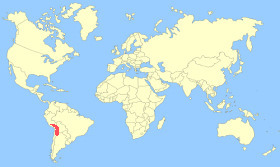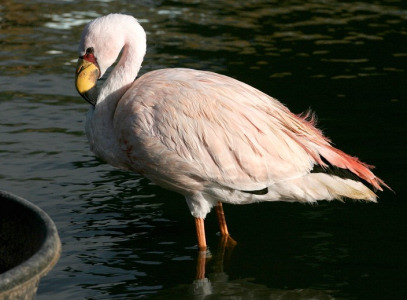Appearance: - The James's Flamingo has a very pale pink plumage with bright carmine streaks around the neck and back, and also black primary flight feathers. They are distinguished from other species of Flamingo by having bright red skin around the eyes, bright yellow beak with a black tip, and red legs. Both sexes are alike but the male is slightly larger. The Andean Flamingo is similar but is larger, has yellow legs, the paler yellow beak has a more extensive black tip, and its wings have more black in them.
Size: - Typical Adult is 90-92cm (35-36in).
Food: - Mainly algae, and diatoms. Flamingos feed by putting their large beak upside down in the water and use their tongue and beak to suck in and filter food from the mud and water.
Habitat/Range: - High mountain lakes and lagoons in the high Andes of southern Peru, Bolivia, north Chile, and north-west Argentina.

 Breeding Habitat/Resident,
Breeding Habitat/Resident,  Migration or Winter Area.
Migration or Winter Area.Breeding Season: - December to February.
Eggs: - 1 (chalky-white colour).
Notes: - The James's Flamingo is also called the Puna Flamingo and is closely related to the Andean Flamingo. The James's Flamingo was named after English naturalist, Henry Berkeley James. The photos on this page are taken at WWT Slimbridge and this is the only James's Flamingo in the UK. He was brought to WWT Slimbridge in 1961 and was already an adult bird so he is at least 60 years old.
Conservation status (IUCN 3.1):
Near Threatened.
Classification: - Family: Phoenicopteridae,
Genus: Phoenicoparrus.




























